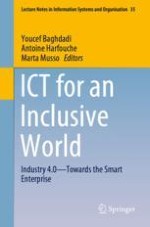This book discusses the impact of information and communication technologies (ICTs) on organizations and on society as a whole. Specifically, it examines how such technologies improve our life and work, making them more inclusive through smart enterprises. The book focuses on how actors understand Industry 4.0 as well as the potential of ICTs to support organizational and societal activities, and how they adopt and adapt these technologies to achieve their goals.
Gathering papers from various areas of organizational strategy, such as new business models, competitive strategies and knowledge management, the book covers a number of topics, including how innovative technologies improve the life of the individuals, organizations, and societies; how social media can drive fundamental business changes, as their innovative nature allows for interactive communication between customers and businesses; and how developing countries can use these technologies in an innovative way. It also explores the impact of organizations on society through sustainable development and social responsibility, and how ICTs use social media networks in the process of value co-creation, addressing these issues from both private and public sector perspectives and on national and international levels, mainly in the context of technology innovations.
